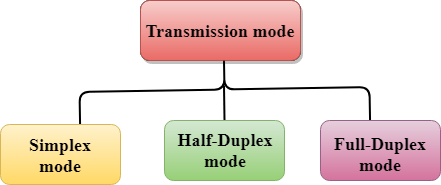- The way in which data is transmitted from one device to another device is known as transmission mode.
- The transmission mode is also known as the communication mode.
- Each communication channel has a direction associated with it, and transmission media provide the direction. Therefore, the transmission mode is also known as a directional mode.
- The transmission mode is defined in the physical layer.
The Transmission mode is divided into three categories:

Simplex mode

- In Simplex mode, the communication is unidirectional, i.e., the data flow in one direction.
- A device can only send the data but cannot receive it or it can receive the data but cannot send the data.
- This transmission mode is not very popular as mainly communications require the two-way exchange of data. The simplex mode is used in the business field as in sales that do not require any corresponding reply.
- The radio station is a simplex channel as it transmits the signal to the listeners but never allows them to transmit back.
- Keyboard and Monitor are the examples of the simplex mode as a keyboard can only accept the data from the user and monitor can only be used to display the data on the screen.
- The main advantage of the simplex mode is that the full capacity of the communication channel can be utilized during transmission.
Half-Duplex mode

- In a Half-duplex channel, direction can be reversed, i.e., the station can transmit and receive the data as well.
- Messages flow in both the directions, but not at the same time.
- The entire bandwidth of the communication channel is utilized in one direction at a time.
- In half-duplex mode, it is possible to perform the error detection, and if any error occurs, then the receiver requests the sender to retransmit the data.
- A Walkie-talkie is an example of the Half-duplex mode. In Walkie-talkie, one party speaks, and another party listens. After a pause, the other speaks and first party listens. Speaking simultaneously will create the distorted sound which cannot be understood.
Full-duplex mode

- In Full duplex mode, the communication is bi-directional, i.e., the data flow in both the directions.
- Both the stations can send and receive the message simultaneously.
- Full-duplex mode has two simplex channels. One channel has traffic moving in one direction, and another channel has traffic flowing in the opposite direction.
- The Full-duplex mode is the fastest mode of communication between devices.
- The most common example of the full-duplex mode is a telephone network. When two people are communicating with each other by a telephone line, both can talk and listen at the same time.